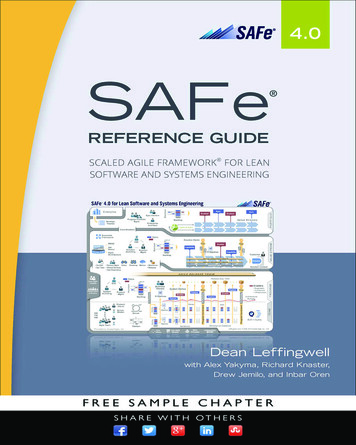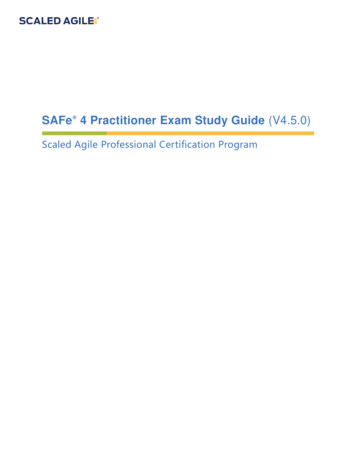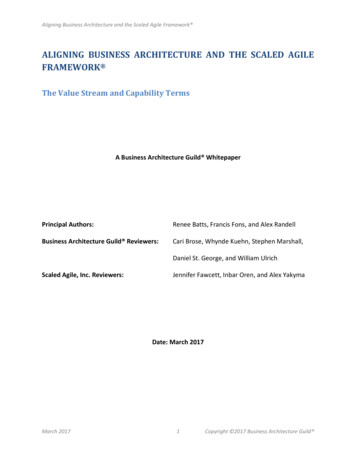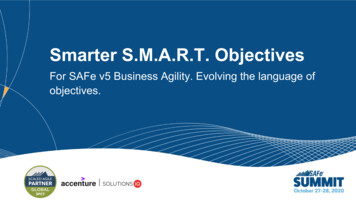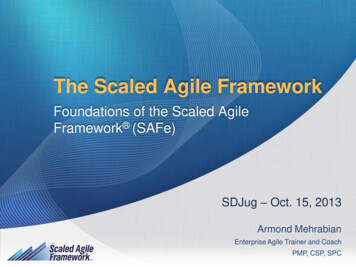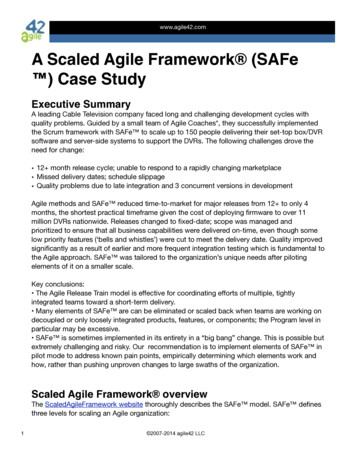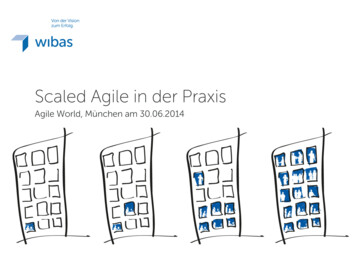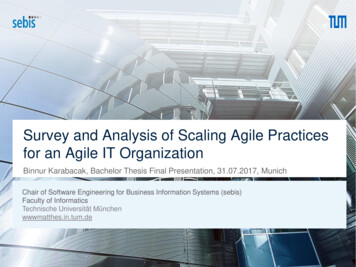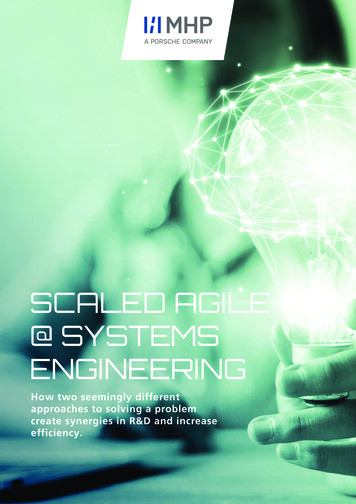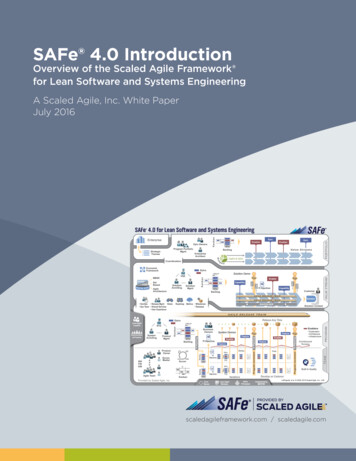
Transcription
SAFe 4.0 IntroductionOverview of the Scaled Agile Framework for Lean Software and Systems EngineeringTEAMPROGRAMVALUE STREAMPORTFOLIOA Scaled Agile, Inc. White PaperJuly 2016PROVIDED BYscaledagileframework.com / scaledagile.com
ForewordTo understand why there is a need for the Scaled Agile Framework (also known as SAFe ), I’mreminded of Jack Welch’s words: “If the rate of change on the outside exceeds the rate of change on theinside, the end is near.”Digital disruption is now causing the rate of change to accelerate in ways that are leaving some of theworld’s largest brands eating the dust of their newer competitors. It’s no longer happening to just a feworganizations in select industries. It’s a reality for every enterprise and government, regardless of size,geography, or industry. It’s easy to see that market leaders have turned that disruption into opportunity,finding ways to quickly adapt to the change, and leverage the disruption to their advantage.This is the new norm. To succeed in this digital adapt-or-die environment, enterprises must be able torapidly change the way they create and deliver value to their customers. Their ability to do that is highlydependent on their dexterity in developing software and systems—the underpinnings of nearly everyfunction in every industry across the globe. As those software and cyber-physical systems becomeincreasingly complex, the methods used to develop those systems must allow the work culture toembrace collaboration, innovation, and speed.The assumptive, one pass, stage-gated, waterfall methods of the past have not scaled to the newchallenge. A more responsive development method is needed to take on the demands of the moderntechnological and cultural landscape. Agile is a major step in that direction, but Agile was developedfor small teams, and by itself, does not scale to the needs of the larger enterprises and the systemsthey create. That’s where SAFe comes into the picture. It applies the power of Agile, but takes it to thenext level by leveraging the more extensive knowledge pools of systems thinking and Lean productdevelopment.SAFe provides comprehensive guidance for achieving the benefits of Lean-Agile development atenterprise scale. It is designed to help enterprises deliver value continuously and more efficiently on aregular and predictable schedule, making them more Agile in the marketplace and more competitivein their industry. Many of the largest organizations in the world have adopted SAFe, and the adoptionrate is accelerating.As you introduce yourself to the Framework, it is important to understand the reasons why theseapproaches work, not just what they are. That’s why SAFe is based on Lean-Agile principles. If youunderstand why things work, you can more easily apply them to your unique context. Also, know thatSAFe, like the marketplace it serves, is an evolving work of innovation and ideas by people committed tothe same mission that you are. It may look a little different from version to version, but its core purposeremains steady, which is to help enterprises build better systems, achieve better business outcomes,and provide better daily lives for the people who build the world’s most important new systems.—Dean LeffingwellCreator of SAFe, and Chief Methodologist, Scaled Agile, Inc.2PROVIDED BY2 2016 Scaled Agile, Inc. All Rights Reserved.
Table of ContentsIntroduction. 1, 2SAFe Core Values.3The Lean-Agile Mindset.4, 5SAFe Lean-Agile Principles.6, 7, 8Program and Team Level.8The Agile Release Train. . 8,9The Spanning Palette.9Agile Teams Power the Train. 10Planning a Program Increment. 11,12Executing a Program Increment.12Inspect and Adapt. . 13Develop on Cadence, Release Any Time. 13Portfolio Level. 14, 15Portfolio Value Streams. 16Lean-Agile Budgeting. 16,17Forecasting.17Value Stream Level. 18Value Stream Flow. 19Realizing Value Streams with ARTs.19,20Leading the Lean-Agile Enterprise. 21, 22Implementing SAFe. 22, 23Summary. 24Learn More. 25Bibliography. 25PROVIDED BY3 2016 Scaled Agile, Inc. All Rights Reserved.
IntroductionThe Scaled Agile Framework (SAFe ) is a freely revealed knowledge base of proven, integrated patternsfor enterprise-scale Lean-Agile development. It is scalable and modular, allowing each organization toapply it in a way that provides better business outcomes and happier, more engaged employees.SAFe synchronizes alignment, collaboration, and delivery for large numbers of Agile teams. It supportsboth software and systems development, from the modest scale of well under 100 practitioners to thelargest software solutions and complex cyber-physical systems, systems that require thousands ofpeople to create and maintain. SAFe was developed in the field, based on helping customers solve theirmost challenging scaling problems. It leverages three primary bodies of knowledge: Agile development,Lean product development, and systems thinking.The SAFe website—scaledagileframework.com—provides comprehensive guidance for scalingdevelopment work across all levels of an enterprise. SAFe’s interactive “Big Picture” (Figure 1) providesa visual overview of the Framework. Each icon on the website is selectable, allowing the user to navigateto an article which provides extensive guidance on the topic area, along with links to related articlesand further information.The Big Picture has two views. The default “3-level view” (Figure 1, left) is well suited for solutions thatrequire a modest number of Agile teams, as well as smaller systems, products and services that arelargely independent of each other. The “4-level view” (Figure 1, right) supports those building large,integrated solutions that typically require hundreds or more practitioners to build and maintain.Figure 1. Big Picture: 3-level and 4-level SAFePROVIDED BY44 2016 Scaled Agile, Inc. All Rights Reserved.1
SAFe can be configured with the three or four organizational levels described above, plus a Foundationlayer, as described below: Team level – SAFe is based fundamentally on Agile teams. Each team is responsible for defining,building, and testing stories (small pieces of new functionality) from their backlog. Teams delivervalue in a series of fixed-length iterations (also called sprints). Teams use a common iterationcadence to synchronize work with other teams; this allows the entire system to iterate simultaneously. Teams employ Scrum (primarily) or Kanban methods. Each of these methods is augmented by built-in quality practices. Many software quality practices are derived from eXtremeProgramming, while hardware and system quality practices are derived from contemporaryLean product development practices. Program level – SAFe teams are organized into a virtual program structure called the “Agile Release Train” (ART). Each ART is a long-lived, self-organizing team of Agile teams (typically 5 to 12),along with other stakeholders, that plan, commit, execute, inspect, and adapt together. ARTs areorganized around the enterprise’s significant value streams. They align teams to a common mission, provide architectural and user experience guidance, facilitate flow, and provide continuousobjective evidence of progress. Value Stream level – The optional Value Stream level supports the development of large andcomplex solutions. These solutions require multiple, synchronized ARTs, as well as strongerfocus on solution intent and solution context. Suppliers and additional stakeholders contributeto this level as well. Pre-and Post Program Increment (PI) planning inform the ARTs (and viceversa) of the Value Stream mission and objectives. Portfolio level – The Portfolio level organizes and funds a set of value streams. The valuestreams realize a set of solutions, which help the enterprise achieve its strategic mission, asdefined in part, by a set of strategic themes. The Portfolio level provides solution developmentfunding via Lean-Agile budgeting, any necessary governance, and coordination of larger development initiatives that affect multiple value streams. Foundation layer – The Foundation layer holds various additional elements that support development. Elements of the Foundation layer include: Lean-Agile Leaders, Communities of Practice,Core Values, Lean-Agile Mindset, and Principles.SAFe is improving business outcomes for government agencies and companies of all sizes across theglobe, resulting in dramatic increases in employee engagement, improved economics, and workplacesthat are more productive, engaging, and fun. Benefits from documented case studies include: 20-50% increase in productivity 30-75% faster time to market 50% defect reduction Happier, more motivated employeesView SAFe case studies from a wide range of industries at scaledagileframework.com/case-studies.PROVIDED BY55 2016 Scaled Agile, Inc. All Rights Reserved.52
SAFe Core Values“Find people who share your values, and you’ll conquer the world together.”—John RatzenbergerThe SAFe Core Values are the guiding principles that dictate behavior and action. These values canhelp people know what is right from wrong, where to put their focus, and how to help companiesto determine if they are on the right path to fulfill their business goals.1.Alignment – Global alignment delivers more value than local optimization [1]. Thereby, individuals on Agile teams value the team’s iteration goals above their personalresponsibilities and tasks. Teams on Agile Release Trains value the achievement of thevision and program objectives over their team objectives. ARTs value the achievementof Value Stream objectives over ART objectives. Value streams most highly value theirability to contribute to portfolio business outcomes. Management is largely responsible for establishing the mission, but does so with the minimum possible constraints.2.Built-in quality – Large systems have more economic sensitivity to quality than dothe features and subsystems that define them. SAFe’s built-in quality practices helpevery team understand and ensure that each solution element, at every increment,achieves appropriate quality standards throughout development. The result is fast,continuous flow with a minimum of delays due to rework, high value delivery velocity,and the highest levels of customer satisfaction.3.Transparency – Large-scale solution development is difficult; things do not alwayswork out as planned. Transparency—sharing progress and facts openly across alllevels—is a key enabler of trust. Trust, in turn, enables fast, decentralized decisionmaking and higher levels of employee empowerment and engagement. Lean-Agileleaders foster trust and transparency by creating an environment of openness, onewhere “the facts are always friendly.”4.Program execution – The ability of each Agile Release Train to routinely and predictably deliver value is a hallmark of a successful SAFe implementation. To this end,SAFe’s Program level provides extensive guidance to the roles and responsibilities—and the most significant activities—that help ARTs accomplish this key objective.PROVIDED BY66 2016 Scaled Agile, Inc. All Rights Reserved.3
The Lean-Agile Mindset“It is not enough that management commit themselves to quality and productivity, they mustknow what it is they must do. Such a responsibility cannot be delegated.”“People are already doing their best. The problem is with the system. Only management canchange the system.”—W. Edwards DemingDeming’s quotes inspire and inform a fundamental premise of SAFe: the ultimate responsibility for thesuccess of the enterprise, and thereby any significant change to the way of working, lies with management.To this end, SAFe describes a new style of leadership, one that is exhibited by SAFe’s Lean-Agile leaders.SAFe Lean-Agile leaders a
The Scaled Agile Framework (SAFe ) is a freely revealed knowledge base of proven, integrated patterns for enterprise-scale Lean-Agile development. It is scalable and modular, allowing each organization to apply it in a way that provides better business outcomes and happier, more engaged employees. SAFe synchronizes alignment, collaboration, and delivery for large numbers of Agile


